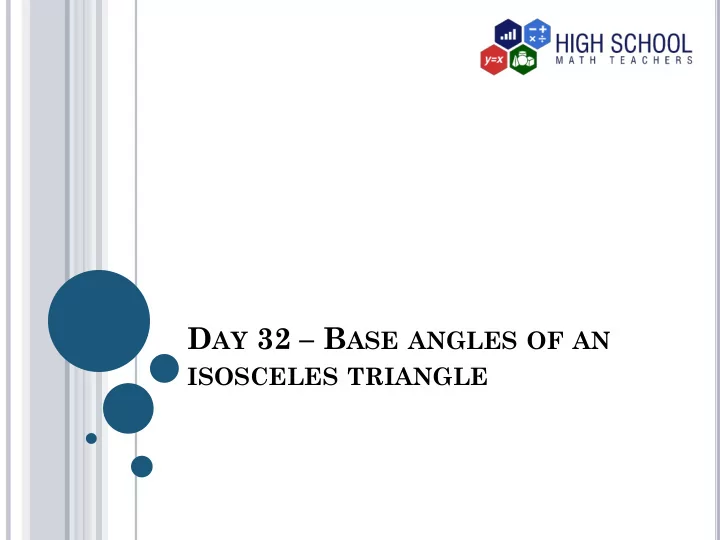

D AY 32 – B ASE ANGLES OF AN ISOSCELES TRIANGLE
I NTRODUCTION There are different types of triangles in geometry, each with its own basic properties. We have discussed and proved the basic properties of triangles in our previous lessons using angles. In this lesson, we are going to deal with one type of a triangle, the isosceles triangle. In a nutshell, we will show that its two base angles are congruent.
V OCABULARY Isosceles triangle A triangle which has at least, two angles congruent and two sides equal. Midpoint of a line segment A point on a line segment that divides it into two equal parts.
An isosceles triangle has the following key properties: (a) Two of its sides are equal (b) Two of its angles are congruent An equilateral triangle has all its three angles equal and all its three sides equal. It is a special kind of an isosceles triangle because it has two angles equal and two sides equal.
An isosceles triangle has the following major parts: A B C ∠ABC ≅ ∠ACD ∠BAC is called the vertex angle BC is called the base AB = AC
We want to show that the base angles of an isosceles triangle are congruent using rigid motion. Let us consider the isosceles triangle PQR shown below. P Q R
From the figure above, ∠PQR and ∠PRQ are the base angles and PQ = PR . First, we locate the midpoint of QR and label it D, then we join point D to point Pas shown below. P R Q D
DP divides angle ∠QPR into two equal angles, ∠DPQ and ∠DPR . Point D divides QR into two equal line segments DQ, and DR . We need to recall that rigid motion preserves distances, and angles. We are going to show that the base angles, ∠PQR , and ∠PRQ are congruent by use of a reflection across DP . DP becomes the mirror line in this case. The angles formed by DP will be mapped onto themselves. ∠DPQ will be mapped onto ∠DPR, and vice versa. Similarly, ∠DQP will be mapped onto ∠DRP , and vice versa.
DQ will also be mapped onto DR , and vice versa. PQ will also be mapped onto PR , and vice versa since a reflection preserves distances. Clearly, we see that ∠𝐐𝐑𝐒 = ∠𝐐𝐒𝐑 We can, therefore, conclude that: If two angles in a given triangle are congruent, then the sides opposite them are also congruent.
Example In the figure below isosceles triangle XYZ is formed by the parallel lines FG and HI. ∠GXZ = ∠XYZ = α . X F G 𝛽 𝛽 Z Y I H
(a) Find the measure of ∠XZY in terms of 𝛽 . (b) Compare ∠XYZ to ∠XZY . What do you notice? Solution (a) ∠XZY and ∠GXZ are alternate angles and therefore equal, therefore, we have: ∠𝐘𝐚𝐙 = ∠𝐇𝐘𝐚 = 𝜷 (b) ∠XYZ = ∠XZY = α . The two angles are congruent.
HOMEWORK In the figure below isosceles triangle ABC is formed by the parallel lines JK and LM. ∠BAJ = ∠CAK = α . A J K 𝛽 𝛽 C B M L
(a) Find the measure of ∠ABC in terms of 𝛽 . (b) Find the measure of ∠ACB in terms of 𝛽 . (c) Compare ∠ABC to ∠ACB . What do you discover?
A NSWERS TO HOMEWORK (a) ∠ABC = 𝛽 (b) ∠ACB = 𝛽 (c) ∠ABC = ∠ACB = 𝛽 ; They are congruent.
THE END
Recommend
More recommend